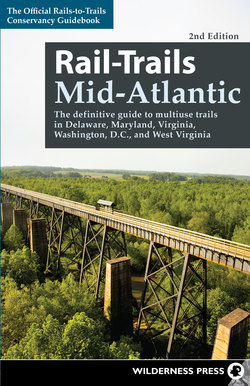Читать книгу Rail-Trails Mid-Atlantic - Rails-to-Trails Conservancy - Страница 10
На сайте Литреса книга снята с продажи.
ОглавлениеIntroduction
Of the more than 1,900 rail-trails across the United States, 147 thread through the Mid-Atlantic region of Delaware; Maryland; Virginia; Washington, D.C.; and West Virginia. These routes relate a two-part story: The first speaks to the early years of railroading, while the second showcases efforts by Rails-to-Trails Conservancy, other groups, and their supporters to resurrect these unused railroad corridors as public-use trails. Rail-Trails: Mid-Atlantic highlights 57 of the region’s diverse trails, each serving as a window into the communities the railroad once served. Some trails delve into the particular history of an area, such as Virginia’s Hanging Rock Battlefield Trail, which tells of Civil War battles and the importance of the railroad to the troops. Other trails, such as Maryland’s Savage Mill Trail, tell a more docile tale. At its trailhead stands a renovated 1822 textile mill.
In this updated edition, we’ve also included some of our favorite multiuse trails. These trails were not previously railroad corridors, but many still have the look and feel of the rail-trails that you’ve come to love. The Mount Vernon Trail in Northern Virginia is a great example of a multiuse trail full of scenic, cultural, and historical charm that is a wonderful corridor to walk, run, skate, or bike.
With the most trails of the region, West Virginia also boasts some of the most rural and unique rail-trails. Not always the flat and even pathways you might expect from rail-trails, West Virginia’s trails offer a variety of backwoods treks, such as the Limerock and Green Mountain Trails of the Monongahela National Forest. Complementing these rustic pathways are the well-groomed yet still wild and wonderful Mountain State trails, such as the gorgeous and popular 77-mile Greenbrier River Trail or Deckers Creek Trail in Morgantown, which is part of the Mon River Rail-Trail System.
Next door, Virginia is also a keeper of rail-trail gems. No guide to the area would be complete without featuring the state’s southern Virginia Creeper National Recreation Trail, which was inducted into the Rail-Trail Hall of Fame in 2014. In the northern part of the state, right outside the bustle of Washington, D.C., the Washington & Old Dominion Regional Park takes riders out of the city and into rolling farmland and horse country.
Washington, D.C., itself is home to a portion of the Capital Crescent Trail, which begins in suburban Maryland before heading to the historical and trendy Georgetown neighborhood. And in the state best known for its crabs and waterways, Maryland’s Cross Island Trail is a coastal sojourn. The only closer you could get would be to meander on Delaware’s Junction & Breakwater Trail, which sits in the heart of the state’s recreational beach area.
No matter which route in Rail-Trails: Mid-Atlantic you decide to try, you’ll be touching on the heart of the community that helped build it and the history that first brought the rails to the region.
What Is a Rail-Trail?
Rail-trails are multiuse public paths built along former railroad corridors. Most often flat or following a gentle grade, they are suited to walking, running, cycling, mountain biking, in-line skating, cross-country skiing, horseback riding, and wheelchair use. Since the 1960s, Americans have created more than 22,000 miles of rail-trails throughout the country.
These extremely popular recreation and transportation corridors traverse urban, suburban, and rural landscapes. Many preserve historic landmarks, while others serve as wildlife conservation corridors, linking isolated parks and establishing greenways in developed areas. Rail-trails also stimulate local economies by boosting tourism and promoting trailside businesses.
What Is a Rail-with-Trail?
A rail-with-trail is a public path that parallels a still-active rail line. Some run adjacent to high-speed, scheduled trains, often linking public transportation stations, while others follow tourist routes and slow-moving excursion trains. Many share an easement, separated from the rails by extensive fencing. More than 240 rails-with-trails currently exist in the United States.
